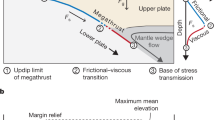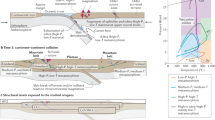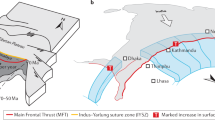Abstract
Jupiter’s volcanic moon Io possesses some of the highest relief in the Solar System: massive, isolated mountain blocks that tower up to 17 km above the surrounding plains. These mountains are likely to result from pervasive compressive stresses induced by subsidence of the surface beneath the near-continual emplacement of volcanic material. The stress state that results from subsidence and warming of Io’s lithosphere has been investigated in detail1,2,3,4; however, the mechanism of orogenesis itself and its effect on regional tectonism and volcanism has not been firmly established. Here we present viscoelastic–plastic finite element simulations demonstrating that Io’s mountains form along deep-seated thrust faults that initiate at the base of the lithosphere and propagate upward. We show that faulting fundamentally alters the stress state of Io’s lithosphere by relieving the large volcanism-induced subsidence stresses. Notably, in the upper portion of the lithosphere, stresses become tensile (near-zero differential stress). A number of processes are therefore altered post-faulting, including magma transport through the lithosphere, interactions with tidal stresses and potentially the localization of mountain formation by thermoelastic stresses. We conclude that Io’s mountains form by a unique orogenic mechanism, compared with tectonic processes operating elsewhere in the Solar System.
This is a preview of subscription content, access via your institution
Access options
Subscribe to this journal
Receive 12 print issues and online access
$259.00 per year
only $21.58 per issue
Buy this article
- Purchase on Springer Link
- Instant access to full article PDF
Prices may be subject to local taxes which are calculated during checkout




Similar content being viewed by others
References
Turtle, E. P. et al. Mountains on Io: high-resolution Galileo observations, initial interpretations, and formation models. J. Geophys. Res. 106, 33175–33200 (2001).
McKinnon, W. B., Schenk, P. M. & Dombard, A. J. Chaos on Io: a model for formation of mountain blocks by crustal heating, melting, and tilting. Geology 29, 103–106 (2001).
Jaeger, W. L. et al. Orogenic tectonism on Io. J. Geophys. Res. 108, 5093 (2003).
Kirchoff, M. R. & McKinnon, W. B. Formation of mountains on Io: variable volcanism and thermal stresses. Icarus 201, 598–614 (2009).
Carr, M. H. et al. Mountains and Calderas on Io: possible implications for lithospheric structure and magma generation. Icarus 135, 146–165 (1998).
Schenk, P. M., Hargitai, H., Wilson, R., McEwen, A. & Thomas, P. The mountains of Io: global and geological perspectives from Voyager and Galileo. J. Geophys. Res. 106, 33201–33222 (2001).
Turtle, E. M., Jaeger, W. L. & Schenk, P. M. in Io After Galileo (eds Lopes, R. M. C. & Spencer, J. R.) 109–132 (Springer, 2007).
Schenk, P. M. & Bulmer, M. H. Origin of mountains on Io by thrust faulting and large-scale mass movements. Science 279, 1514–1517 (1998).
McEwen, A. S. et al. Galileo at Io: results from high-resolution imaging. Science 288, 1193–1198 (2000).
Kirchoff, M. R., McKinnon, W. B. & Schenk, P. M. Global distribution of volcanic centers and mountains on Io: control by asthenospheric heating and implications for mountain formation. Earth Planet. Sci. Lett. 301, 22–30 (2011).
Hamilton, C. W. et al. Spatial distribution of volcanoes on Io: implications for tidal heating and magma ascent. Earth Planet. Sci. Lett. 361, 272–286 (2013).
Ahern, A., Radebaugh, J., Christiansen, E. & Harris, R. Structural mapping of paterae and mountains on Io: implications for crustal stresses and feature evolution, Abstr. P31C-2073, in AGU Fall Meeting (AGU, 2015).
Keszthelyi, L. et al. New estimates for Io eruption temperatures: implications for the interior. Icarus 192, 491–502 (2007).
McGovern, P. J., Kirchoff, M. R., White, O. L. & Schenk, P. M. Magma ascent pathways associated with large mountains on Io. Icarus 272, 246–257 (2016).
Barton, C. A., Zoback, M. D. & Moos, D. Fluid flow along potentially active faults in crystalline rock. Geology 23, 683–686 (1995).
Schaber, G. G. The surface of Io: geologic units, morphology, and tectonics. Icarus 43, 302–333 (1980).
Heath, M. J. in Papers Presented to the Conference on Heat and Detachment in Crustal Extension on Continents and Planets 50–54 (Lunar and Planetary Institute, 1985).
McEwen, A. S. in Papers Presented to the Conference on Heat and Detachment in Crustal Extension on Continents and Planets 76–80 (Lunar and Planetary Institute, 1985).
Bunte, M. K., Williams, D. A., Greeley, R. & Jaeger, W. L. Geologic mapping of the Hiíaka and Shamshu regions of Io. Icarus 207, 868–886 (2010).
Bart, G. D., Turtle, E. P., Jaeger, W. L., Keszthelyi, L. P. & Greenberg, R. Ridges and tidal stress on Io. Icarus 169, 111–126 (2004).
Strom, R. G., Trask, N. J. & Guest, J. E. Tectonism and volcanism on Mercury. J. Geophys. Res. 80, 2478–2507 (1975).
Watters, T. R. et al. The tectonics of Mercury: the view after MESSENGER’s first flyby. Earth Planet. Sci. Lett. 285, 283–296 (2009).
Byrne, P. K. et al. Mercury’s global contraction much greater than earlier estimates. Nature Geosci. 7, 301–307 (2014).
Watters, T. R. & Johnson, C. L. in Planetary Tectonics (eds Watters, T. R. & Schultz, R. A.) 121–182 (Cambridge Univ. Press, 2010).
Boyer, S. E. & Elliot, D. Thrust systems. AAPG Bull. 66, 1196–1230 (1982).
McEwen, A. S., Keszthelyi, L. P., Lopes, R., Schenk, P. M. & Spencer, J. R. in Jupiter: The Plant, Satellites, and Magnetosphere (eds Bagenal, F., Dowling, T. & McKinnon, W. B.) 307–328 (Cambridge Univ. Press, 2004).
Geissler, P., McEwen, A. S., Philips, C., Keszthelyi, L. & Spencer, J. R. Surface changes on Io during the Galileo mission. Icarus 169, 29–64 (2004).
Battaglia, S. M., Stewart, M. A. & Kieffer, S. W. Io’s theothermal (sulfur)—lithosphere cycle inferred from sulfur solubility modeling of Pele’s magma supply. Icarus 235, 123–129 (2014).
Melosh, H. J. & Raefsky, A. The dynamical origin of subduction zone topography. Geophys. J. R. Astron. Soc. 60, 333–354 (1980).
Mackwell, S. J., Zimmerman, M. E. & Kohlstedt, D. L. High-temperature deformation of dry diabase with application to tectonics of Venus. J. Geophys. Res. 103, 975–984 (1998).
Bland, M. T. & McKinnon, W. B. Forming Ganymede’s grooves at smaller strain: toward a self-consistent local and global strain history for Ganymede. Icarus 245, 247–262 (2015).
Colmenares, L. B. & Zoback, M. D. A statistical evolution of intact rock failure criteria constrained by polyaxial test data for five different rocks. Int. J. Rock Mech. Min. 39, 695–729 (2002).
Vermeer, P. A. & de Borst, R. Non-associated plasticity for soils, concrete, and rocks. Heron 29, 1–64 (1984).
Bland, M. T., McKinnon, W. B. & Showman, A. P. The effects of strain localization on the formation of Ganymede’s grooved terrain. Icarus 210, 396–410 (2010).
O’Reilly, T. C. & Davies, G. F. Magma transport of heat on Io: a mechanism allowing a thick lithosphere. Geophys. Res. Lett. 8, 313–316 (1981).
Khurana, K. K. et al. Evidence of a global magma ocean in Io’s interior. Science 332, 1186–1189 (2011).
Pritchard, M. E. & Stevenson, D. J. in Origin of the Earth and Moon (eds Canup, R. M. & Righter, K.) 179–196 (Univ. Arizona Press, 2000).
Klimczak, C., Byrne, P. K. & Solomon, S. C. A rock-mechanical assessment of Mercury’s global tectonic fabric. Earth Planet. Sci. Lett. 416, 82–90 (2015).
Acknowledgements
This work was supported by NASA’s Planetary Geology and Geophysics Program (NNX11AP16G) and Solar System Workings Program (NNH15AZ80I). M.T.B. thanks T. Becker for technical guidance in the production of Fig. 1.
Author information
Authors and Affiliations
Contributions
M.T.B. designed and performed the finite element model simulations, analysed simulation results and prepared the manuscript. W.B.M. contributed to the design and analysis of the finite element model simulations and manuscript preparation.
Corresponding author
Ethics declarations
Competing interests
The authors declare no competing financial interests.
Rights and permissions
About this article
Cite this article
Bland, M., McKinnon, W. Mountain building on Io driven by deep faulting. Nature Geosci 9, 429–432 (2016). https://doi.org/10.1038/ngeo2711
Received:
Accepted:
Published:
Issue Date:
DOI: https://doi.org/10.1038/ngeo2711
This article is cited by
-
A model of crust–mantle differentiation for the early Earth
Acta Geochimica (2022)
-
Impact-induced changes in source depth and volume of magmatism on Mercury and their observational signatures
Nature Communications (2017)



